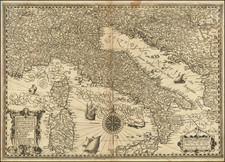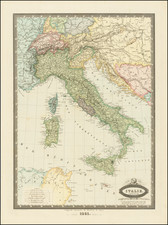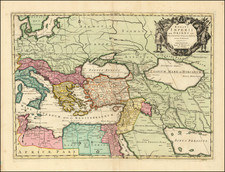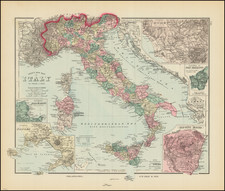Rare late edition of the Nolin map of Tuscany and the Papal States, centered on Lake Trasimeno.
As with other maps by Nolin, the attention to details is apparent. In this instance, Nolin has utilized the indigeneous maps of Giacomo Cantelli as one of his important sources.
The map shows the fortified cities of Sienna, Florence, Lucca, Pisa, Perugia, Ravenne, and more. The city of Rome is shown with its extensive fortifications and the Vatican is located with an icon. The aqueducts from the mountains to Rome are well shown. The map is filled with details and icons locating rivers, topography, villages, churches, and more. At lower left, an inset detailing the provinces of Ferrare and a portion of Bologna to include the city of Bologna are shown. The large title cartouche completely fills the upper right corner.
This edition carries the imprint "A Paris Chez l'Auteur rue Saint Iacques…" with an earlier imprint to the left that is mostly rubbed out of the plate. Other editions of the map include different addresses, including:
A present Rue. St. Jacquest au d'essus de la Rue des Mathurins a lens.aume de Place des Victoirs et du Lion D'Argent . . . A Paris Chez L'Auteur sur le Quay de L'Horologie du Palais a L'Enseign de la Place de Vitoirce Vers le Pont Neuf. L'on trouve aussi chez lui toutes les Carte particuieres des autres Etats d'Italie Avec Privilege du Roi.
(Biblioteca Nacional De Portugal--undated edition).
A Paris Chez L'Auteur sur le Quay de L'Horologie du Palais a L'Enseign de la Place de Vitoirce Vers le Pont Neuf. L'on trouve aussi chez lui toutes les Carte particuieres des autres Etats d'Italie Avec Privilege du Roi.
( Bibliothèque nationale de France (France)--Collection D'Anvillle).
Jean-Baptiste Nolin (ca. 1657-1708) was a French engraver who worked at the turn of the eighteenth century. Initially trained by Francois de Poilly, his artistic skills caught the eye of Vincenzo Coronelli when the latter was working in France. Coronelli encouraged the young Nolin to engrave his own maps, which he began to do.
Whereas Nolin was a skilled engraver, he was not an original geographer. He also had a flair for business, adopting monikers like the Geographer to the Duke of Orelans and Engerver to King XIV. He, like many of his contemporaries, borrowed liberally from existing maps. In Nolin’s case, he depended especially on the works of Coronelli and Jean-Nicholas de Tralage, the Sieur de Tillemon. This practice eventually caught Nolin in one of the largest geography scandals of the eighteenth century.
In 1700, Nolin published a large world map which was seen by Claude Delisle, father of the premier mapmaker of his age, Guillaume Delisle. Claude recognized Nolin’s map as being based in part on his son’s work. Guillaume had been working on a manuscript globe for Louis Boucherat, the chancellor of France, with exclusive information about the shape of California and the mouth of the Mississippi River. This information was printed on Nolin’s map. The court ruled in the Delisles’ favor after six years. Nolin had to stop producing that map, but he continued to make others.
Calling Nolin a plagiarist is unfair, as he was engaged in a practice that practically every geographer adopted at the time. Sources were few and copyright laws weak or nonexistent. Nolin’s maps are engraved with considerable skill and are aesthetically engaging.
Nolin’s son, also Jean-Baptiste (1686-1762), continued his father’s business.









![Regnum Siciliae Cum circumjacentibus Regnis et Insulis… [shows Malta] (Heighten with Gold Leaf)](https://storage.googleapis.com/raremaps/img/small/50376.jpg)

![[ Atlas of Italy ] Topographia Italiae, das ist: Warhaffte und curiöse Beschreibung von gantz Italien. Darinnen nach historischer Warheit, die berühmtesten Städte, Vestungen, Marckflecken und andere Oerter, sampt ihren Antiquitäten](https://storage.googleapis.com/raremaps/img/small/102001.jpg)


